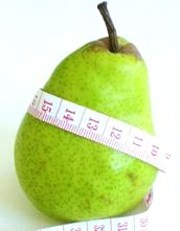15 Healthy Diet Tips for Fat Loss (Cont'd)
Looking for healthy diet tips to support your fat loss efforts? Here's a collection of great nutrition related tips that can help you lose body fat without compromising your health.
Note that this is the second page of a two-page article on healthy diet tips for people who want to lose body fat without losing muscle. If you missed the first page of the article, click here.
#9: Restrict Calories, Especially in the Evening
To lose excess body fat, you will have to create a calorie deficit. You can achieve that either by reducing calorie intake from foods so that your body must draw on reserves for energy (such as fat stored within your body) or by increasing physical activity. To lose 1 pound per week, you will have to achieve a weekly deficit of 3,500 calories. This can be done by reducing a daily caloric intake by 500 calories (500 calories x 7 days = 3,500 calories). Most experts recommend a caloric deficit of 3,500 to 7,000 per week for healthy and successful weight loss.

An extreme deficit (a deficit of more than 7,000-10,500 calories per week), however, is not healthy and it can even lead to serious health problems such as heart rhythm abnormalities which can be fatal. Furthermore, cutting too many calories may also be counterproductive to fat loss efforts as extremely low calorie diets boost the activity of fat-storing enzymes and decrease the activity of fat-burning enzymes in the body. Cutting too many of calories may also accelerate loss of lean muscle mass and decrease the output of the thyroid hormone, which will result in a decrease in the metabolic rate and thus fewer calories will be burned throughout the day.
In addition to restricting the calories consumed, fat people should pay attention to the timing of the daily caloric intake. It is generally recommended to spread the calories throughout the day by having 5-6 small meals. This will keep the metabolism going and control cravings for sweets and starches. The breakfast should be the biggest meal of the day as a big breakfast will help get your metabolism humming and you will burn more fat throughout the day.
#10: Limit Your Alcohol Consumption
Not only is excessive alcohol consumption unhealthy, it can also sabotage your fat loss diet. So, here's a tip: limit drinking to special occasions! With 7 calories per gram, alcohol is very high in calories (it is nearly as calorie dense per gram as fat). Most of the indigested alcohol is converted into acetate by the liver, which is then released into the bloodstream. Studies have shown that acetate is used by the body in preference over other fuels, particularly fat, thus putting the brakes on fat loss. In addition, an alcoholic drink either prior to, or during a meal, has been shown to increase the caloric intake at the meal, probably due to the appetite promoting effects of alcohol. Furthermore, frequent heavy drinking can compromise muscle mass as alcohol encourages the production of cortisol, a hormone that breaks down muscle tissue for use as a fuel.
#11: Watch Out for Fats but Don't Eliminate the Good Fats Completely
A high intake of dietary fat can lead to fat accumulation and weight gain. Fat contains more than twice as many calories as protein or carbohydrates. A gram of fat provides 9 calories (39kJ) whereas a gram of protein or carbohydrates contains 4 calories (16.8kJ). Fats are also the least filling of all the macronutrients (you become hungry sooner after a fatty meal than a meal high in fiber-rich carbohydrates or protein).
What's more, fat has a low thermogenic effect, that is, the body uses very little energy for the breakdown of fat (only 0-3% of its calorific value). In contrast, protein has a high thermogenic effect (20-30%), which means that the body burns a significant share of the calories provided by a protein-rich meal in the process of breaking down and digesting the meal.
That said, it is important not to completely eliminate all fats from diet. Essential fatty acids (EFAs)—which are concentrated in nuts, seeds, fatty fish and unrefined whole grains—are crucial for the proper functioning of the body. These fats cannot be synthesized by the body and must therefore be obtained through diet.
In contrast, saturated fats—found in foods from animal sources like meat and dairy—should be avoided. These fats have been shown to promote fat accumulation and weight gain more than the unsaturated EFAs. The body does need saturated fats in very small amounts for some particular purposes, but the body is able to synthesize its own saturated fatty acids when needed.
Trans fats, yet another type of fat, should be completely eliminated from diet. These fats are formed in a chemical process that food manufacturers use to turn liquid oils into solid fats and to increase the shelf life of foods. They are most often found in fried foods, vegetable shortenings, hard margarine, cookies, crackers, chips, and baked goods. In addition to their other detrimental effects on health, trans fats can lead to a higher overall body weight, even when the total caloric intake is controlled. In one animal study, male monkeys were fed either a western-style diet containing trans fats or a diet that contained monounsaturated fats such as olive oil. All monkeys received the same, modest amount of calories. The monkeys who ate trans fats had a 7.2% increase in body weight, compared to a 1.8 percent increase in monkeys that were fed monounsaturated fats.
#12: Drink Plenty of Water
Don't underestimate the importance of this healthy fat loss diet tip – drinking plenty of water is crucial for successful fat loss (and a healthy body)! Water provides no calories but can increase the feeling of fullness. In fact, it has been suggested that drinking large volumes of ice-cold water could actually burn calories. This is because ice water needs to be warmed to body temperature when it enters the body, which requires energy (calories). Consuming 2 liters of ice water a day would result in roughly 70 extra calories burned.
What's more, staying well hydrated encourages the body to use the kidneys, rather than the liver, for eliminating waste products. One of the liver's main functions is the conversion of energy from stored body fat. If the liver does not have to focus on eliminating waste products, it can concentrate on mobilizing body fat.
#13: Opt for Low-GI Carbs
Carbs that have a high Glycemic Index (GI) rating are quickly broken down by the body and cause a rapid, large rise in blood glucose levels, which in turn triggers the pancreas to release large amounts of insulin. Insulin is necessary for the body to be able to use glucose for energy, but high amounts of insulin promote fat storage in the body. In contrast, low-GI carbs, which take much longer to digest, cause only a small, slow rise in the blood glucose and insulin levels. In addition, low-GI foods reduce cravings – which could lead to fat gain – as they provide the body with a slow, steady supply of energy. Most non-starchy vegetables, legumes and fruit have a low GI rating while most refined carbohydrate-rich foods and potatoes are rated high on the Glycemic Index.
#14: Ensure a Sufficient Intake of Vitamin D, Also in Winter
Vitamin D is present in a few foods such as egg yolks, fish, liver, and certain fortified dairy products. The body is also able to synthesize its own vitamin D when exposed to sunlight. A lack of vitamin D has been linked to obesity and increased fat accumulation in the body.

Nevertheless, scientists have not been able to determine whether it is the low concentrations of vitamin D that cause fat gain or whether it is the accumulated body fat that results in to lower levels of vitamin D. Some experts believe that a lack of vitamin D – associated with negligible levels of sunlight during winter months – could in fact be the key trigger for what is known as 'winter response'. This winter response is characterized by increased fat accumulation, which was critical to the survival of our ancestors that lived in cold ambient temperatures.
#15: Burn More Calories with Capsaicin
This fat loss tip will turn your body into a fat-burning furnace! Several studies suggest that capsaicin, the major pungent ingredient in cayenne peppers, can increase the body's heat production (thermogenesis), thereby increasing the rate at which the body burns carbohydrates and fats. One study showed that capsaicin in hot chillies could increase the resting metabolic rate (RMR) by up to 25% (the RMR is the rate at which the body burns carbohydrates and fats at rest). The effects on the metabolic rate peaked at 75 to 90 minutes after the consumption of the capsaicin and lasted for up to three hours.
Furthermore, research suggests that capsaicin can suppress appetite and reduce the amount of calories consumed during subsequent meals: In one trial, half of the subjects were given tomato juice with chili powder, while the rest drank it plain. Those who received the drink containing the capsaicin consumed 16% fewer calories on average.

